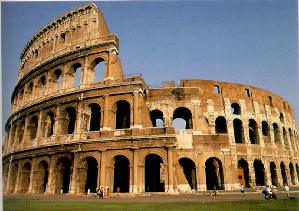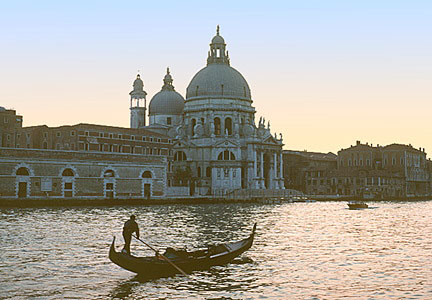Famous Cities |
|
| Bologna: Known for its left-wing politics
and the rich, full-flavored Bolognese cuisine, this city
is sometimes called "red" Bologna, on account
of the reddish color of most of its buildings and the
communist flavor of the local political leaders. Bologna
was the first city in in Italy to elect a communist town
council, and it is the headquarters of the National Gay
Alliance. The University of Bologna, still the thriving
center of the city, is Europe's oldest university. Less
crowded than Firenze, Roma, or Venezia, Bologna makes a
relaxing tourist destination. Firenze (Florence): A major center of Renaissance literary and visual culture during the Medieval and Renaissance period, Firenze was home to authors including Dante, Boccaccio, and Machiavelli and artists Botticelli, DaVinci, and Michelangelo. More recently, it was the home of Carlo Lorenzini, the 19th-century author who first brought us the story of Pinocchio. Although Firenze's art museums are among the finest in the world, Florentine architecture is so fascinating the city itself is sometimes called "a living museum" because it's impossible to turn a corner without coming upon something fascinating. Genoa: Birthplace of Christopher Columbus and the famous violinist NicolÚ Paganini, Genoa is Italy's most important commercial seaport. It has been selected by the European Union as the 2004 European Capital of Culture. Its daring, vertigo-inducing modern architecture makes an interesting contrast to the historic buildings along the maze of narrow streets in the city center. The Strada Nuova, or Via Garibaldi, is an excellent example of 16th-century urban planning; the aristocratic palaces along its length include inviting gardens and beautiful interiors that are open to visitors. Milano (Milan): The financial and fashion center of Italy, Milano's spectacular fashion shows have made the reputation of many a designer. Via Montenapoleone, which houses many of the world's leading Italian and international fashion design houses, is an upscale shopper's paradise. Milano is the location of La Scala, the most famous opera house in the world, and the home of Leonardo da Vinci's renowned fresco, The Last Supper. Milano is also a good starting point for a day trip to Italy's lake district, as it is located near the three largest lakes in the nation. Napoli (Naples): Capital of the southern region of Campania, Napoli is the third largest city in Italy. A buzzing metropolis, Napoli is exciting and fast-paced, with an unusually active street life and a distinctive tomato-based cuisine, often consumed al fresco. It was the Neapolitans who invented pizza! Napoli even has its own language, the Neapolitan dialect. Parts of the city still echo the urban lay-out of the city of Neapolis founded on this site by Greeks in the 5th century B.C.: the cardo, a narrower street running from north to south, and the decumano, a wider street that runs from east to west. Padova (Padua): The nerve center for communication in northeast Italy, Padova is a prosperous high-tech city that retains a strong sense of history. Nestled at the base of the picturesque Colli Euganei hills, Padova boasts beautiful botanical gardens as well as exciting museums. The 12th-century Palazzo della Ragione, with its great hall on the upper floor, is reputed to have the largest roof unsupported by columns in Europe. The residents themselves claim that Padova is the oldest city in north Italy and that it was founded by the Trojan hero Antenor, whose relics were supposedly found in a large stone sarcophagus exhumed in the year 1274. Palermo: The regional capital of Sicily, Palermo was founded as a port by the Phoenicians in the 8th century B.C. It has the largest ancient and medieval historical district of any Italian city outside of Roma, with a fascinating mix of different influences. At times in its history this city was dominated by Romans, Arabs, Normans, Swabians, and Spaniards, all of whom left their distinctive fingerprint on the city layout and architecture. Palermo's Sicilian desserts, especially the pastries, are stuffed with ingredients like marzipan and ricotta and are famous for being extremely rich and filling. Pise (Pisa): Pise's origins are Etruscan (pre-Roman), though it became a Roman colony in 179 B.C. In the twelfth through fourteenth centuries it was a flourishing center of art and culture: it was the birthplace of Nicola Pisano, the great Gothic sculptor, and Leonardo Pisano, better known as "Fibonacci," who was one of the most brilliant mathematicians in history. Home of the famous "leaning tower," this coastal city was the summer residence of the powerful Medici family, who dominated Italian politics during the Renaissance. Pompeii: Destroyed by the eruption of the volcano Vesuvius in 79 A.D., Pompeii was buried under the ashes for 1700 years. Today it is an astonishing time capsule of the classical Roman past. Visitors can walk the ancient streets and experience the ancient world in a way impossible anywhere else on earth, then relax at modern resorts on the nearby island of Capri, where the Caesars maintained their vacation homes. Roma (Rome): As the capital of Italy and the center of the powerful Roman Empire, it has often been said that all roads lead to Roma. Visitors still marvel over the remains of the Colosseum and other wonders of ancient architecture. The historical treasures in the many museums of Roma and Vatican City, which is located inside of Roma but is a state of its own with its own laws and administration, are unrivaled anywhere. Throw a coin into Roma's Trevi fountain and, legend has it, one day you will return! Sienne (Sienna): Sienne's Palio della Contrade, its greatest tourist attraction, is a unique and dangerous neck-or-nothing horse race along the perimeter of the Piazza del Campo that takes place every July and August. Riders carry flags representing the city's 17 districts, and spectators carry on historical pageantry throughout the festival. Throughout the rest of the year, Sienne offers excellent examples of historic conservation, gorgeous Tuscan countryside, and a breathtaking view from the Torre del Mangia belltower. Sorrento: Overlooking the Bay of Naples, Sorrento is a haven of tourism with excellent connections to nearby Napoli and Capri and the archaeological sites of Pompeii and Herculaneum. The city has a reputation as a playground for the rich and famous. Popular local destinations include an ancient Carmelite hermitage known as the Deserto, and the Sirens' Grotto, which inspires curiosity with the unusual colors of its waters and interesting ruins of ancient buildings along the coast. Torino (Turin): The bustling center of Italy's motor car industry, Torino is the location of one of Italy's most prominent universities. Torino is where the controversial "Shroud of Turin," believed by many to be the burial shroud of Jesus Christ, was discovered in a vault in the fourteenth century. As the capital of Italy's Piemonte (Piedmont) region, Torino's architectural attractions include the royal palaces of the Savoy dynasty. The Mole Antonelliana, a tall nineteenth-century brick building topped by an aluminium spire that towers above the landscape, has been reproduced on Italy's Euro 2-cent coins. In 2006, Torino will host the Winter Olympics. Venezia (Venice): Venezia's world-famous canals and gondolas are its most famous feature, but the city is also celebrated for its well-preserved Gothic-style architecture and art history. St. Mark's Square (Piazza San Marco), the center of Venice's water transport system, offers a daily spectacle of people-watching. Piazza San Marco is bounded by several monuments: the Basilica di San Marco; the Palace of the Doge, the elected Duke who ruled the city from the 8th century until Napoleon Bonaparte took the city in 1797; and the Museo Correr, "The Museum of the City and Civilization of Venice," housed in an arcade originally built by Napoleon. Verona: The setting of Shakespeare's Two Gentlemen of Verona and Romeo and Juliet, Verona's history goes back to the Roman period. Thanks to active efforts in preservation over the past several centuries, the city has an unusually high number of well-preserved Roman edifices. One of its most important landmarks is the Arena, the old Roman amphitheater whose walls were extended in the third century. The ancient Roman theater, originally built for gladiatorial competitions, seats over 22,000 people and now houses operas--and a Shakespeare festival!--under the stars every summer. Verona is one of the most prosperous cities in northern Italy, just as it was in Shakespeare's day. You can still visit the Capulet family's house, though there's some question whether Juliet Capulet herself ever lived there. |
|
 |
 |